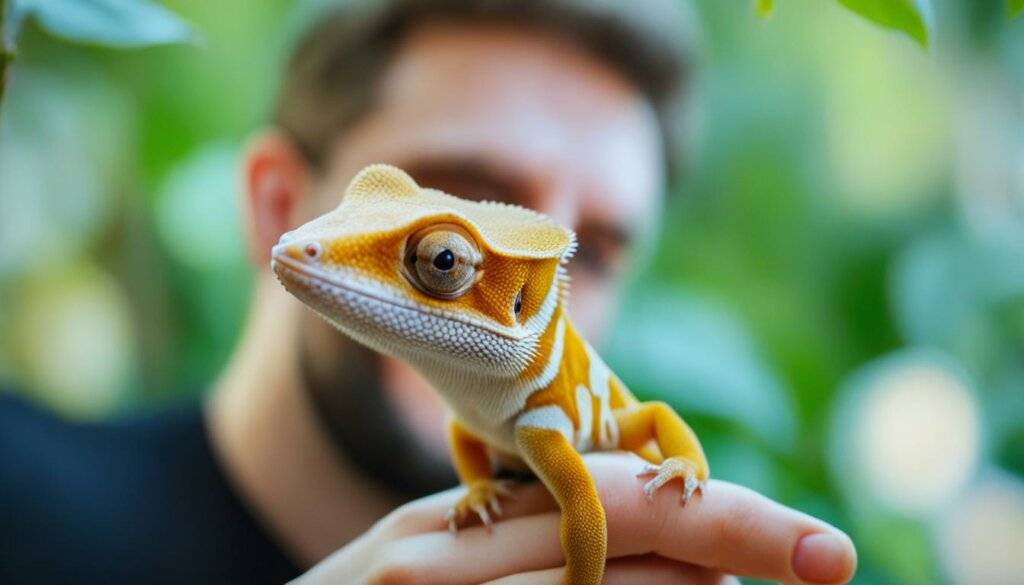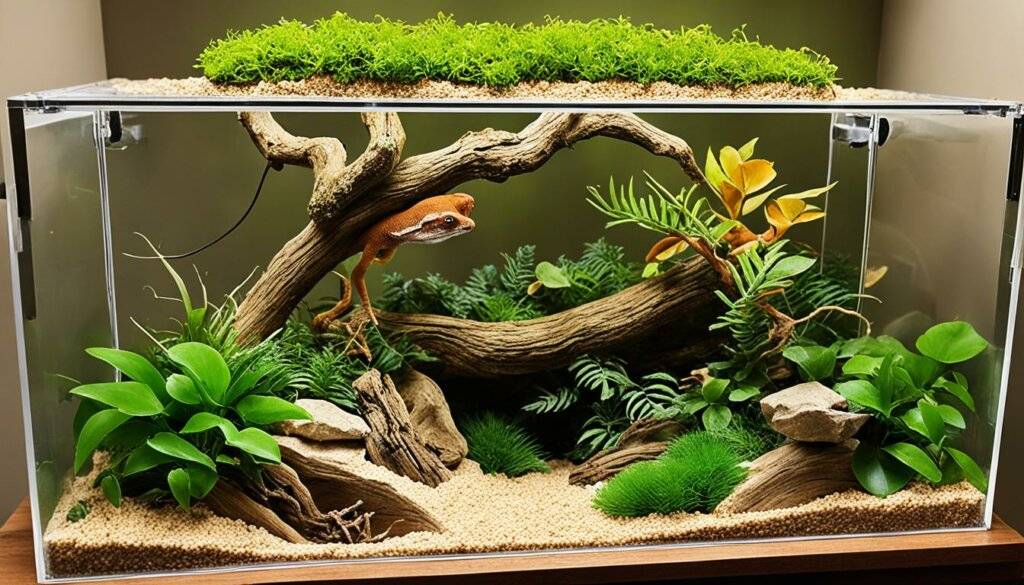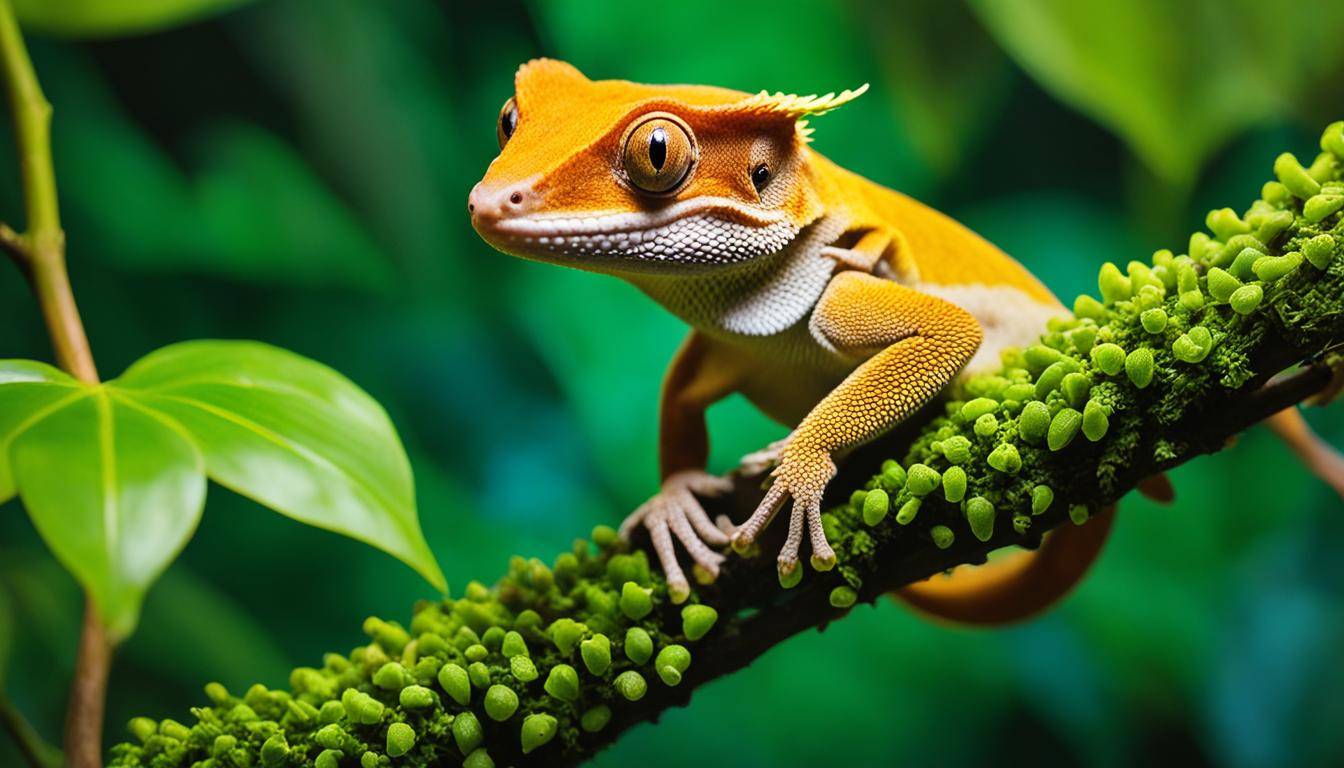Welcome to the world of crested geckos! If you’re looking for a pet that is both popular and low-maintenance, then the crested gecko is the perfect choice for you. These fascinating reptiles have captured the hearts of pet enthusiasts worldwide with their unique features and easy care requirements.
Crested geckos are known for their distinctive appearance, including eyelash-like projections over their eyes and soft spines along their sides. They typically reach lengths of around 4 to 4.5 inches and are semi-arboreal, meaning they spend most of their time in small trees. With a lifespan of up to 15 to 20 years, crested geckos make wonderful long-term companions.
One of the main attractions of crested geckos is their low-maintenance nature. They are ideal for beginners or those with busy schedules, as they require minimal special care. In this article, we will explore the characteristics and care requirements of crested geckos, including their housing needs, diet, and handling.
Key Takeaways:
- Crested geckos are popular pets due to their unique features and low-maintenance nature.
- They reach lengths of around 4 to 4.5 inches and have a lifespan of up to 15 to 20 years.
- Crested geckos thrive at room temperature and do not require specialized heating or lighting setups.
- They can be fed a Pangea crested gecko diet or supplemented with live insects like small crickets.
- Crested geckos have calm and docile temperaments and tolerate handling well.
Characteristics and Care Requirements
Crested geckos are a popular choice for pet reptiles due to their unique characteristics and low-maintenance care requirements. Whether you’re a beginner or have a busy schedule, these fascinating creatures are a perfect fit for your lifestyle.
One of the advantages of owning a crested gecko is that they thrive at room temperature, eliminating the need for complicated heating or lighting setups. Unlike other reptiles, they can comfortably live in an environment with average household conditions.
When it comes to housing, adult crested geckos should be provided with at least a 20-gallon tank to ensure they have plenty of space to explore and climb. Creating a natural and stimulating environment is important, so be sure to include branches, driftwood, cork bark, and vines for them to climb on. Live plants such as Epipremnum and Philodendron not only add aesthetic appeal but also create hiding places for your gecko.
Humidity is crucial for crested geckos, and it can be easily maintained by misting their enclosure with warm, filtered water on a daily basis. This step is essential to meet their moisture needs and promote overall health and wellbeing.
When it comes to their diet, crested geckos are omnivores. One convenient and nutritious option is the Pangea crested gecko diet, a powdered mix that provides all the essential nutrients your gecko needs. This diet can be supplemented with live insects such as small crickets for added variety and enrichment.
When caring for your crested gecko, it’s important to maintain a clean environment. Remove any uneaten food and spot clean the enclosure daily to prevent the buildup of waste. Monthly deep cleaning involves thoroughly cleaning the tank and decorations to ensure your gecko’s habitat remains hygienic.
In summary, crested geckos are a joy to care for due to their low-maintenance nature and captivating characteristics. By providing them with a suitable tank setup and a balanced diet, you can enjoy their company for many years to come.
Behavior and Handling
Understanding the behavior of crested geckos is key to providing them with the best care possible. While juveniles may exhibit skittishness, adult crested geckos are known for their calm and docile temperaments. They tolerate handling well, making them great pets for those who enjoy interacting with their reptilian companions. However, it’s important to handle them in short periods to avoid causing stress.
Crested geckos are primarily nocturnal creatures, which means they are most active during the evening and early morning hours. This behavior is beneficial for individuals who work or have busy schedules, as it allows for quality time with the gecko outside of typical working hours.
One fascinating aspect of crested gecko behavior is their remarkable climbing and jumping abilities. They are excellent climbers, thanks to their specialized toe pads, which allow them to effortlessly navigate various surfaces. Their prehensile tails further aid in balance and agility, making them skilled jumpers as well.
“Crested geckos are known for their calm and docile temperaments, making them great pets for those who enjoy interacting with their reptilian companions.”
When handling crested geckos, it’s important to create a calm and secure environment. By gentling scooping them up, supporting their body with your hands and fingers, and avoiding sudden movements, you can ensure a positive handling experience for both you and the gecko. Remember to always wash your hands before and after handling to prevent the transfer of bacteria or contaminants.
Now that you have a better understanding of crested gecko behavior and handling, let’s move on to exploring their housing and enclosure needs.

-
Save
Housing and Enclosure
When it comes to providing a comfortable and stimulating living environment for your crested gecko, an appropriate enclosure is essential. Opting for a vertical tank setup allows your gecko to utilize their natural climbing instincts and provides them with ample space to explore. While a 20-gallon terrarium is the minimum size recommended for an adult, providing a larger tank offers even more room for your gecko to thrive and exercise.
The key to setting up a suitable terrarium for your crested gecko lies in creating a habitat that mimics their natural environment. This includes incorporating a variety of branches, driftwood, cork bark, and vines for them to climb on and explore. These elements not only encourage physical activity but also provide hiding spots that contribute to your gecko’s sense of security.
Adding live plants, such as Epipremnum and Philodendron, not only enhances the aesthetics of the enclosure but also provides additional hiding places for your gecko. Live plants can create a more natural and inviting environment and can contribute to maintaining adequate humidity levels within the enclosure.

-
Save
To ensure the cleanliness and hygiene of your crested gecko’s enclosure, regular cleaning and substrate replacement are necessary. Regularly remove any waste and uneaten food to prevent the buildup of bacteria. Cleaning the tank and decorations on a monthly basis helps maintain a healthy environment for your gecko to thrive in.
| Enclosure Type | Ideal Size | Benefits |
|---|---|---|
| Glass Terrarium | Minimum 20-gallon tank | Allows for an unobstructed view and easy maintenance |
| Screen Enclosure | Minimum 18x18x24 inches | Offers increased ventilation and airflow |
| Wooden Vivarium | Minimum 48x24x24 inches | Provides insulation and promotes natural humidity |
The table above summarizes different enclosure options and their respective benefits. Choosing the right type and size of enclosure for your crested gecko is crucial to ensure their well-being and happiness.
Temperature and Lighting
Proper temperature and lighting are essential factors in maintaining the health and well-being of your crested gecko.
Temperature
Crested geckos require a temperature gradient to imitate their natural habitat. During the day, the temperature should range between 72°F and 80°F (22°C and 27°C). At night, it’s important to lower the temperature to a range of 65°F to 75°F (18°C to 24°C). Ensuring this gradient allows your gecko to thermoregulate and choose the temperature that suits them best.
It is crucial to carefully monitor the temperature inside the enclosure. Crested geckos are sensitive to higher temperatures and can suffer from heat stress or even overheating, which can be fatal. Use a reliable thermometer to keep track of the temperature and make adjustments if necessary.
Lighting
While crested geckos do not necessarily require UVB lighting, providing a low level of UVB (around 5%) can have benefits for their overall health. UVB rays help with vitamin D synthesis and calcium absorption, which is important for bone health. However, it’s crucial to control the intensity and duration of UVB exposure to prevent any potential harm.
Additionally, proper lighting helps regulate your gecko’s circadian rhythm. A consistent day and night cycle helps maintain their natural behavior and keeps them healthy and active.
For lighting, you can use a low-wattage red nighttime bulb to provide a gentle heat source and maintain the appropriate temperature during the night. Avoid using bright or intense lighting at night, as it can disrupt their sleep patterns.
Temperature and Lighting Recommendations
| Temperature | Lighting |
|---|---|
| Day: 72-80°F (22-27°C) | Low level of UVB (around 5%) |
| Night: 65-75°F (18-24°C) | Low-wattage red nighttime bulb |
Humidity and Substrate
Maintaining proper humidity levels is essential for the well-being of your crested geckos. These reptiles thrive in environments with humidity levels ranging from 50% to 70%. To ensure adequate humidity in the enclosure, regular misting with warm, filtered water is recommended. This helps to create a humid microclimate, which is especially important at night when the geckos are most active.
Choosing the right substrate is also crucial for maintaining humidity levels in the enclosure. Various substrates can be used, such as coconut fiber bedding, moss, or peat. These materials have excellent moisture retention properties and help to create a suitable environment for your crested geckos. Avoid using substrates like reptile sand, as they can pose a swallowing hazard and may interfere with the humidity levels.
To summarize:
- Maintain humidity levels between 50% and 70%.
- Mist the enclosure regularly with warm, filtered water.
- Use substrates like coconut fiber bedding, moss, or peat for better humidity retention.
- Avoid substrates like reptile sand.
By ensuring proper humidity and choosing the right substrate, you can create a comfortable and thriving habitat for your crested geckos.
Expert Tip:
“Monitoring the humidity levels is crucial, as excessively high or low humidity can lead to health issues for your crested geckos. Invest in a hygrometer to accurately measure the humidity levels in the enclosure and make adjustments as needed.”
Health and Maintenance
As wonderful and low-maintenance as crested geckos are, it’s important to be aware of potential health issues. While they are generally healthy pets, certain conditions can arise. Common problems include mouth rot or stomatitis, respiratory infections, and skin issues. It’s essential to monitor your gecko closely and seek veterinary care if you notice any signs of illness.
Regular maintenance plays a crucial role in keeping your crested gecko healthy. Removing uneaten food and spot cleaning the enclosure daily helps maintain a clean and hygienic environment. Additionally, a thorough monthly cleaning of the tank and decorations is necessary to prevent bacteria and parasites from accumulating.
Diet is another critical aspect of crested gecko care. A balanced diet is essential for their overall health and well-being. Providing a mixture of commercial gecko food and live prey insects ensures they receive the necessary nutrients. It’s also important to offer fresh water daily and supplement their diet to prevent any nutritional deficiencies.
